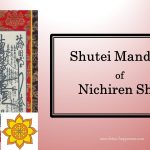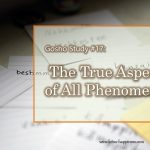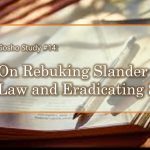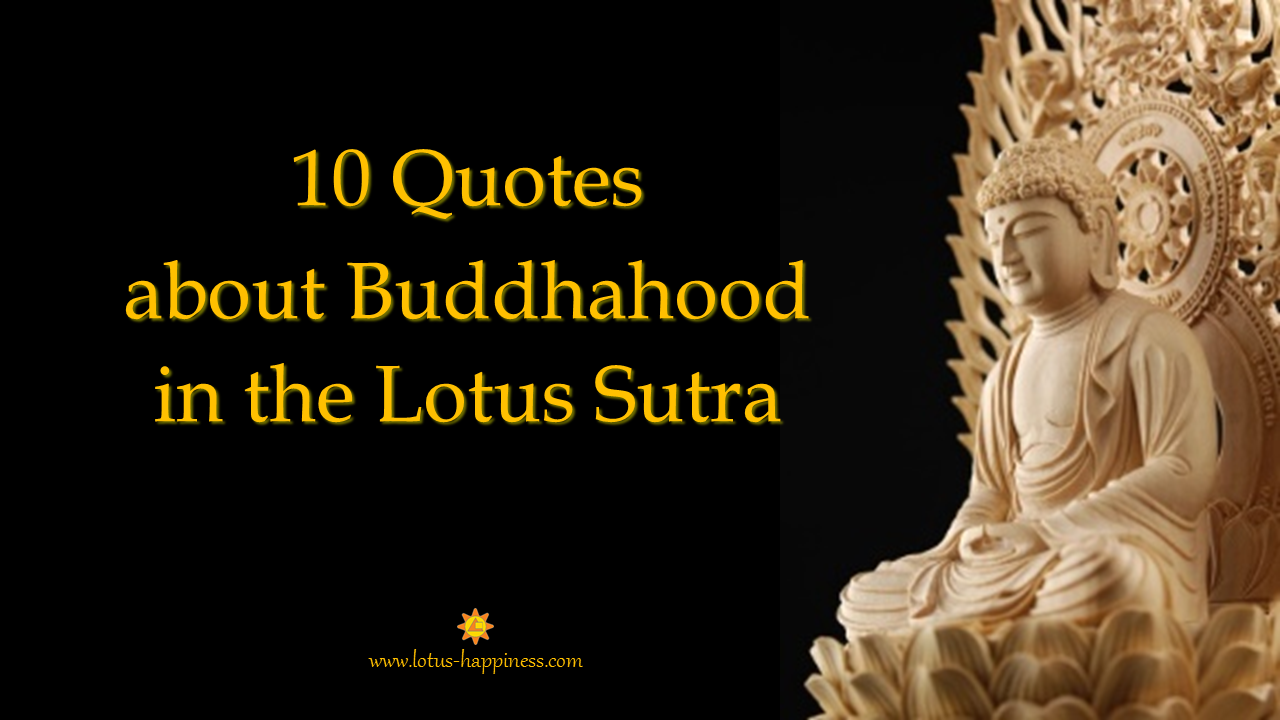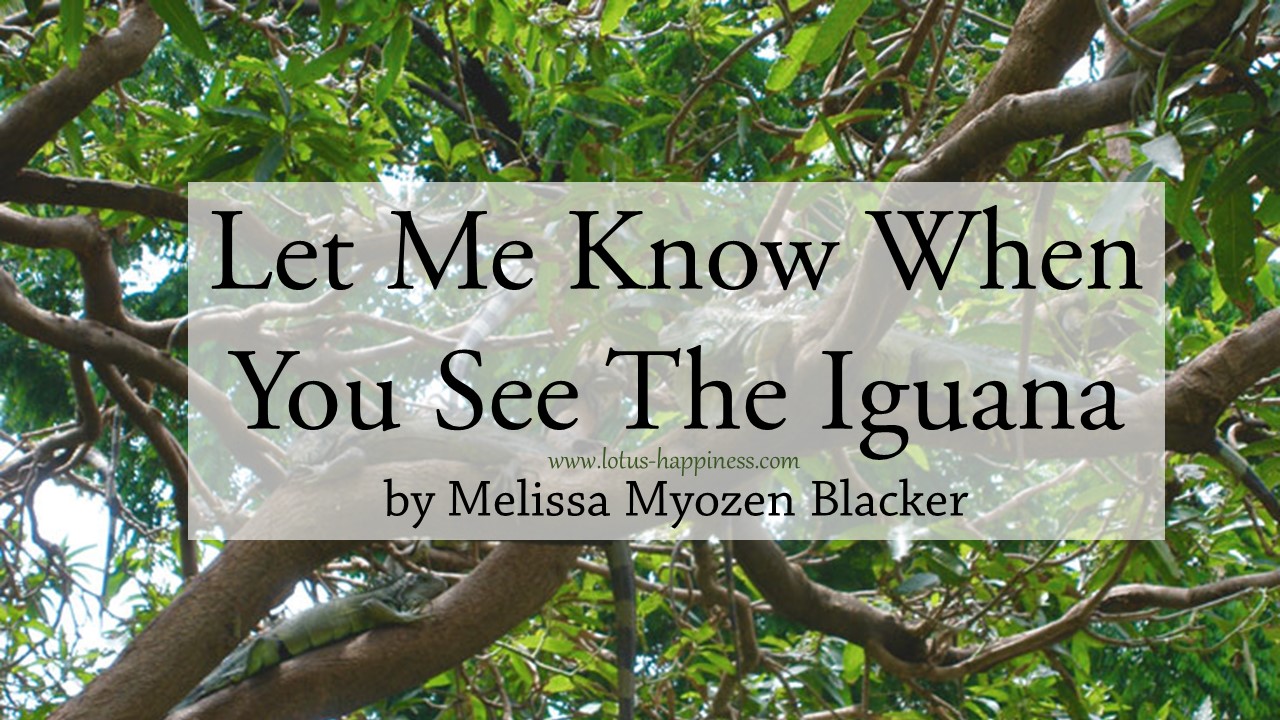
The Gohonzon is the object of worship for practitioners of Nichiren Buddhism. Nichiren Daishonin inscribed the Dai-Gohonzon on 12 October 1279 in Japan so that people in the Latter Day of the Law has an external object to focus their minds upon the “inner Gohonzon” within them.
The Gohonzon is the object of worship for practitioners of Nichiren Buddhism. Nichiren Daishonin inscribed the Dai-Gohonzon on 12 October 1279 in Japan so that people in the Latter Day of the Law has an external object to focus their minds upon the “inner Gohonzon” within them.
The Gohonzon is just like a spiritual mirror; it reflects the inner state of Buddhahood inherent within us. When we chant in front of the Gohonzon, we need to perceive the Buddha inside of us. Chanting the daimoku of Nam Myoho Renge Kyo is a way to polish our Buddha-nature and elevate our state to Buddhahood.
Never seek this Gohonzon outside yourself. The Gohonzon exists only within the mortal flesh of us ordinary people who embrace the Lotus Sutra and chant Nam-myoho-renge-kyo. – The Real Aspect of the Gohonzon, p832
Have you ever wondered who are the Buddhas, bodhisattvas and heavenly deities in the Gohonzon? Let’s find out more.
This version of the Gohonzon is inscribed by 26th high priest of Nichiren Shoshu tradition, Nichikan. It is the standard Gohonzon conferred to members of the Soka Gakkai International. The following is the key to the accompanying diagram. The key gives the phoneticized original, English translation and Sanskrit of characters on the Gohonzon transcribed by Nichikan.
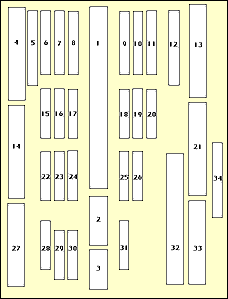
#1 – Nam-myoho-renge-kyo
#2 – Nichiren
#3 – Zai gohan-This is Nichiren Daishonin’s personal seal.
#4 – Dai Bishamon-tenno-Great Heavenly King Vaishravana (Skt.), also called Tamon-ten (Hearer of Many Teachings).
#5 – U kuyo sha fuku ka jugo-Those who make offerings will gain good fortune surpassing the ten honorable titles [of the Buddha. Note: In Buddhism, making offerings has a broad meaning; here it means to respect and praise.
#6 – Namu Anryugyo Bosatsu-Bodhisattva Firmly Established Practices (Skt. Supratishthitacharitra). Note: The word namu is added to some names in the Gohonzon as a sign of great respect.
#7 – Namu Jyogyo Bosatsu-Bodhisattva Pure Practices (Skt. Vishuddhacharitra).
#8 – Namu Shakamuni-butsu-Shakyamuni Buddha.
#9 -Namu Taho Nyorai-Many Treasures Thus Come One (Skt. Prabhutaratna Tathagata).
#10 -Namu Jogyo Bosatsu-Bodhisattva Superior Practices (Skt. Vishishtacharitra).
#11 – Namu Muhengyo Bosatsu-Bodhisattva Boundless Practices (Skt. Anantacharitra).
#12 – Nyaku noran sha zu ha shichibun-Those who vex and trouble [the practitioners of the Law] will have their heads split into seven pieces.
#13 – Dai Jikoku-tenno-Great Heavenly King Upholder of the Nation (Skt. Dhritarashtra).
#14 – Aizen-myo’o-Wisdom King Craving-Filled (Skt. Ragaraja). Note: The name is written in Siddham, a medieval Sanskrit orthography.
#15 – Dai Myojo-tenno-Great Heavenly King Stars, or the god of the stars.
#16 – Dai Gattenno-Great Heavenly King Moon, or the god of the moon.
#17 – Taishaku-tenno-Heavenly King Shakra (also known as Heavenly King Indra).
#18 – Dai Bontenno-Great Heavenly King Brahma.
#19 – Dai Rokuten no Mao-Devil King of the Sixth Heaven.
#20 – Dai Nittenno-Great Heavenly King Sun, or the god of the sun.
#21 – Fudo-myo’o-Wisdom King Immovable (Skt. Achala). Note: The name is written in Siddham, a medieval Sanskrit orthography.
#22 – Hachi Dairyuo-Eight Great Dragon Kings.
#23 – Dengyo Daishi-Great Teacher Dengyo.
#24 – Jurasetsunyo-Ten Demon Daughters (Skt. Rakshasi).
#25 – Kishimojin-Mother of Demon Children (Skt. Hariti).
#26 – Tendai Daishi-Great Teacher T’ien-t’ai.
#27 – Dai Zojo-tenno-Great Heavenly King Increase and Growth (Skt. Virudhaka).
#28 – Hachiman Dai Bosatsu-Great Bodhisattva Hachiman.
#29 – Kore o shosha shi tatematsuru-I respectfully transcribed this.
#30 – Nichikan, personal seal-Signature of the high priest who transcribed this Gohonzon, in this case, Nichikan, consisting of his name and personal seal.
#31 – Tensho-daijin-Sun Goddess.
#32 – Butsumetsugo ni-sen ni-hyaku san-ju yo nen no aida ichienbudai no uchi mizou no daimandara nari-Never in 2,230-some years since the passing of the Buddha has this great mandala appeared in the world.
#33 – Dai Komoku-tenno-Great Heavenly King Wide-Eyed (Skt. Virupaksha).
#34 – Kyoho go-nen roku-gatsu jusan-nichi-The 13th day of the sixth month in the fifth year of Kyoho [1270], cyclical sign kanoe-ne.
______________________________________
The following section gives further explanation of the diagram of the Nichikan-transcribed Gohonzon. The numbering of each term corresponds to the numbering on the diagram.
Many of the Buddhist gods’ names include words such as Dai and tenno. Dai is an honorific term meaning great; tenno means heavenly king. The word namu is added to some names as a sign of great respect.
1. Nam-myoho-renge-kyo: The ultimate Law permeating all phenomena in the universe. The fundamental component of Nichiren Daishonin’s Buddhism, it expresses the true entity of life that allows people to directly tap their enlightened nature. Although the deepest meaning of Nam-myoho-renge-kyo is revealed only through its practice, the literal meaning is: nam (devotion), the action of practicing Buddhism; myoho (Mystic Law), the entity of the universe and its phenomenal manifestations; renge (lotus flower, which blooms and seeds at the same time), the simultaneity of cause and effect; kyo (sutra, the voice or teaching of a Buddha), all phenomena. The invocation of Nam-myoho-renge-kyo was established by Nichiren Daishonin, on April 28, 1253, at Seicho-ji temple in the province of Awa.
2. Nichiren (1222-82): The founder of the Buddhism upon which the SGI bases its activities. He inscribed the true object of worship, the Gohonzon, for the observation of one’s mind and established the invocation of Nam-myoho-renge-kyo as the universal practice to attain enlightenment. Daishonin is an honorific title that means great sage. He was born on February 16, 1222, in the small fishing village of Kominato in Awa Province in what is presently Chiba Prefecture, Japan. In his writings he states that inscribing the Gohonzon, “…is the reason for my advent in this world” (MW-1, p. 30).
3. Zai gohan: Literally, zai means to exist; go is an honorific prefix, and in this case, denotes “Nichiren Daishonin’s”; han means personal seal. Nichiren Daishonin is said to have instructed those who inscribe the Gohonzon to place the word gohan under his name.
4. Dai Bishamon-tenno (Great Heavenly King Vaishravana): One of the Four Heavenly Kings, who appear in the Lotus Sutra and vow to protect those who embrace the sutra. Bishamon lives halfway down the northern side of Mount Sumeru1 and protects the north, accompanied by the two classes of demons called yaksha (Jp. yasha) and rakshasa (rasetsu). Bishamon is a transliteration of the Sanskrit Vaishravana. This god is said to always protect the place where the Buddha preaches and listen to the Buddha’s teachings. In the twenty-sixth chapter of the Lotus Sutra, he pledges to protect the votaries of the sutra.
5. “Those who make offerings will gain good fortune surpassing the ten honorable titles of the Buddha.” The ten honorable titles that express a Buddha’s power, wisdom, virtue and compassion are:
a. Thus Come One-one who has come from the world of truth. A Buddha embodies the fundamental truth of all phenomena and grasps the law of causality permeating past, present and future.
b. Worthy of Offerings-one who is qualified to receive offerings from human and heavenly beings.
c. Right and Universal Knowledge-one who comprehends all phenomena correctly and perfectly.
d. Perfect Clarity and Conduct-one who understands the eternity of past, present and future, and who performs good deeds perfectly.
e. Well Gone-one who has gone to the world of enlightenment.
f. Understanding of the World-one who understands all secular and religious affairs through his grasp of the law of causality.
g. Unexcelled Worthy-one who stands supreme among all living beings.
h. Leader of People-one who instructs and leads all people to enlightenment.
i. Teacher of Gods and Humans-A teacher who can guide all human and heavenly beings.
j. Buddha, the World-Honored One-an awakened one, endowed with perfect wisdom and virtue, who can win the respect of all people.
6. Namu Anryugyo Bosatsu (Bodhisattva Firmly Established Practices): One of the four bodhisattvas who are the leaders of the Bodhisattvas of the Earth. He appears in the fifteenth chapter of the Lotus Sutra. According to Tao-hsien’s2 “Supplement to the Words and Phrases of the Lotus Sutra” (Hokke Mon gu Fusho Ki), the four bodhisattvas represent the four virtues of the Buddha: true self eternity, purity and happiness. Bodhisattva Anryugyo represents happiness, the unshakable state of life filled with joy.
7. Namu Jyogyo Bosatsu (Bodhisattva Pure Practices): One of the four leaders of the Bodhisattvas of the Earth. He appears in the fifteenth chapter of the Lotus Sutra. Tao-hsien’s Hokke Mongu Fusho Ki says that the four bodhisattvas represent the four virtues of the Buddha’s life-true self, eternity, purity and happiness. Bodhisattva Jyogyo represents purity; the pure state of life that is never swayed by circumstances.
8. Namu Shakamuni-butsu (Shakyamuni Buddha): The first recorded Buddha and founder of Buddhism, born about 2,500 years ago. He was the son of Shuddhodana, the king of the Shakyas, a small tribe whose kingdom was located in the foothills of the Himalayas south of what is now central Nepal. Shakya of Shakyamuni is taken from the name of this tribe and muni means sage or saint. His family name was Gautama (Best Cow) and his given name was Siddhartha (Goal Achieved), though some scholars say this is a title bestowed on him by later Buddhists in honor of the enlightenment he attained. For fifty years, he expounded various sutras (teachings), culminating in the Lotus Sutra, which he declared his ultimate teaching. The Lotus Sutra provides the theoretical basis for the Gohonzon.
9. Namu Taho Nyorai (Many Treasures Thus Come One): A Buddha who appears, seated within the Treasure Tower, at the Ceremony in the Air to bear witness to the truth of Shakyamuni’s teachings in the Lotus Sutra. According to the eleventh chapter of the Lotus Sutra, Taho Buddha lived in the world of Treasure Purity in an eastern part of the universe. While still engaged in bodhisattva practice, he pledged that, even after he had entered nirvana, he would appear, in the Treasure Tower, and attest to the validity of the Lotus Sutra wherever anyone might teach it. In the eleventh chapter, Shakyamuni assembles all the Buddhas from throughout the universe. He then opens the Treasure Tower and at Taho’s invitation seats himself at this Buddha’s side.
T’ien-t’ai interprets Taho and Shakyamuni seated side by side in the Treasure Tower as the fusion of reality and wisdom (Jp. kyochi myogo), with Taho representing the objective truth or ultimate reality, and Shakyamuni, the subjective wisdom to realize it. Moreover, Taho Buddha represents the property of the Law, Shakyamuni Buddha, the property of wisdom, and the Buddhas from throughout the universe, the property of action; together they represent the “three properties.”3
Nichiren Daishonin uses these interpretations of T’ien-t’ai and further states in the “Heritage of the Ultimate Law of Life” that Shakyamuni and Taho represent, respectively, life and death, the two phases that the entity of life undergoes.
10. Namu Jogyo Bosatsu (Bodhisattva Superior Practices): One of the four bodhisattvas and the leader of the Bodhisattvas of the Earth. He appears in the fifteenth chapter of the Lotus Sutra. Tao-hsien says in the Hokke Mongu Fusho Ki that the four bodhisattvas represent the four virtues of the Buddha’s life: true self, eternity, purity and happiness. Among these, Jogyo represents the virtue of true self. Nichiren Daishonin interprets Bodhisattva Jogyo as the provisional or ephemeral figure of the original Buddha of kuon ganjo4 projected at the Ceremony in the Air (See September 1997 Living Buddhism, pp. 8-10.)
11. Namu Muhengyo Bosatsu (Bodhisattva Bound-less Practices): One of the four bodhisattvas who lead the Bodhisattvas of the Earth. Muhengyo literally means no boundary and represents eternity, one of the four virtues of the Buddha’s life.
12. Nyaku noran sha zu ha shichibun: “Those who vex and trouble [the practitioners of the Law] will have their heads split into seven pieces.” An analogy for the fact that negative causes against the Mystic Law will produce loss in one’s life.
13. Dai Jikoku-tenno (Great Heavenly King Upholder of the Nation): One of the Four Heavenly Kings. He lives halfway down the eastern side of Mount Sumeru and protects the eastern quarter. In the twenty-sixth chapter of the Lotus Sutra, he pledges to protect those who embrace the sutra.
14. Aizen-myo‘o (Wisdom Craving-Filled): A Buddhist deity who is said to purify people’s earthly desires and free them from illusions and the sufferings accruing from earthly desires. In the esoteric teachings,5 his true identity is regarded as Dainichi (Skt. Mahavairochana) Buddha or Kongosatta (Skt. Vajrasattva). His name is inscribed in Siddham, a medieval Sanskrit orthography, on the left hand side of the Gohonzon as one faces it, signifying the principle that “earthly desires are enlightenment.”
15. Dai Myojo-tenno (Great Heavenly King Stars, or the god of the stars): A deification of the stars in Indian mythology incorporated into Buddhism as one of the twelve gods.6
16. Dai Gattenno (Great Heavenly King Moon): A deification of the moon in Indian mythology, incorporated into Buddhism as one of the twelve gods.
17. Taishaku-tenno (Heaven King Shakra, also known as Heavenly King Indra):One of the main tutelary gods of Buddhism, together with Bonten. He is also one of the twelve gods said to protect the world. Originally the god of thunder in Indian mythology he was later incorporated into Buddhism as a protective deity. He lives in a palace called Correct Views or Joyful to See in the Trayastrimsha Heaven on the peak of Mount Sumeru and, served by the Four Heavenly Kings, governs the other thirty-two gods of that heaven.
While Shakyamuni was engaged in bodhisattva practice, Taishaku is said to have assumed various forms to test his resolve. According to the first chapter of the Lotus Sutra, he joined the assembly on Eagle Peak,7 accompanied by 20,000 retainers.
18. Dai Bontenno (Great Heavenly King Brahma): A god said to live in the first of the four meditation heavens in the world of form above Mount Sumeru and to rule the saha8 world. In Indian mythology he was regarded as the personification of the fundamental universal principle (Brahman), and in Buddhism he was adopted as one of the two major tutelary gods, together with Taishaku.
19. Dai Rokuten no Mao (Devil King of the Sixth Heaven): Many devils appear in Indian and Buddhist scriptures, the most formidable and powerful of which is the Devil King of the Sixth Heaven. He is the king of devils who dwells in the highest of the six heavens of the world of desire and delights in manipulating others to do his will. He is regarded as a symbol of lust for power He is also called Takejizaiten, the king who makes free use of the fruits of others’ efforts for his own pleasure. Served by innumerable minions, he works to obstruct Buddhist practice and delights in sapping the life force of other beings. He corresponds to the last of “the three obstacles and four devils”9. Nichiren Daishonin interprets this devil as the manifestation of the fundamental darkness inherent in life. Especially in Buddhism devils are interpreted to mean functions that work to block or hinder people in their Buddhist practice.
20. Dai Nittenno (Great Heavenly King Sun): The divinity of the sun, adopted in Buddhism as a protective god. He is said to be a subject of Taishaku.
21. Fudo–myo‘o (Wisdom King Immovable): A Buddhist deity who serves practitioners by defeating the obstacles and evils that hinder Buddhist practice. It is said that he enters into a flame-emitting meditation in which he exudes flames that destroy all karmic hindrances. Because he never yields to obstacles, he is called Fudo (immovable). He is popularly depicted as an angry figure surrounded by flames, holding a rope and a sword. He signifies that “the sufferings of birth and death are nirvana (Jp. shoji soku nehan).”
22. Hachi Dairyuo (Eight Great Dragon Kings): Kings of the dragons said to live at the bottom of the sea. Eight dragon kings, each with many followers, assembled at the ceremony on Eagle Peak to hear the Lotus Sutra. According to the Kairyuo Sutra (Sutra of the Dragon King of the Sea), dragons are often eaten by giant birds called garudas, their natural enemy.
23. Dengyo Daishi (Great Teacher Dengyo): The founder of the Tendai sect in Japan. He is also called Saicho. At age 12, he entered the Buddhist Order and studied under Gyohyo at the provincial temple in Omi. In April 785, he was fully ordained at Todai-ji temple, receiving the 250 precepts. In June of the same year, he went to Mount Hiei and built a small retreat there where he devoted himself to the study of Buddhist scriptures and treatises, especially those of the T’ien-t’ai school.
In 804, Dengyo went to T’ang China accompanied by his disciple, Gishin. There he studied T’ien-t’ai Buddhism under Miao-lo’s disciple Tao-sui who was then staying at Lung-hsing-ssu temple. After that, Dengyo went to Mount T’ien-t’ai where he studied under Hsing-man, another disciple of Miao-lo. In 805, he returned to Japan and the next year established the Tendai sect. At that time, all priests were ordained exclusively in the Theraveda precepts. Dengyo made continuing efforts to secure imperial permission for the building of a Mahayana ordination center on Mount Hiei, despite concentrated opposition from the older sects of Nara. Permission was finally granted a week after his death, and in 827, the ordination center was completed by his successor, Gishin. In addition to this project, after his return to Japan, Dengyo concentrated his efforts on refuting the interpretations of the older Buddhist sects. In particular, his ongoing debate with Tokuichi, a priest of the Hosso sect, is well known. This debate began in the early Konin era (810-824). Tokuichi asserted that the one-vehicle teaching of the Lotus Sutra was a provisional teaching that Shakyamuni Buddha expounded in accordance with the people’s capacity, while the three-vehicle teachings were true teachings, and that there are some people who are without the potential to attain Buddhahood. In opposition to this assertion, Dengyo maintained that all people have the Buddha nature and that the supreme vehicle of Buddhahood expounded in the Lotus Sutra is the true teaching. He was a key figure in upholding the righteousness of the Lotus Sutra in the Middle Day of the Law.
24. Jurasetsunyo (Ten Demon Daughters; also known as the Ten Goddesses): The ten daughters of the female demon Kishimojin (Skt. Hariti). They are Ramba (Lamba), Biramba (Vilamba), Kokushi (Kutadanti) or Crooked Teeth, Keshi (Pushpadanti) or Flowery Teeth, Kokushi (Makutadanti) or Black Teeth, Tahotsu (Keshini) or Much Hair, Muenzoku (Achala) or Insatiable, Jiyoraku (Maladhari) or Necklace Bearer, Kodai (Kunti), and Datsu Issaishujo Shoke (Sarvasattvojohari) or Robber of the Vital Spirit of All Living Beings. In the twenty-sixth chapter of the Lotus Sutra, they pledge to protect the sutra’s votaries.
25. Kishimojin (Mother of Demon Children): A female demon, said to have been a daughter of a yaksha demon in Rajagriha, India. She had 500 children (some sources say 1,000 or 10,000). According to the Kishimo Sutra (Sutra of Kishimojin) and the Binaya Zoji (Monastic Rules With Respect to Various Matters), she killed the babies of other people to feed her children, and the terrified and grieving populace begged Shakyamuni for help. The Buddha then hid Kishimojin’s youngest son, Binkara. She sought him throughout the world for seven days, but to no avail. In despair she finally asked the Buddha where he was. Shakyamuni rebuked her for her evil conduct and made her vow never to kill another child. Then he returned her son to her. Kishimojin was revered in India as a goddess who could bestow the blessings of children and easy delivery. Kishimojin worship was later introduced to Japan. In the twenty-sixth chapter of the Lotus Sutra, she and her ten daughters pledged before the Buddha to safeguard the votaries of the Lotus Sutra.
26. Tendai Daishi (Great Teacher T’ien-t’ai, also called Chih-i): The founder of the Chinese T’ien-t’ai school, commonly referred to as the Great Teacher T’ien-t’ai. his name and title were taken from Mount T’ien-t’ai, where he lived.
T’ien-t’ai refuted the scriptural classifications formulated by the ten major Buddhist schools of his day, which based themselves either on the Kegon (The Flower Garland Sutra) or Nirvana Sutra, and devised the classification of “the five periods and eight teachings,” thereby establishing the supremacy of the Lotus Sutra. He also expounded the theory of “a life-moment possessing 3,000 realms” (ichinen sanzen). Because he systematized both its doctrine and method of practice, he is revered as the founder of the school. If Shakyamuni’s Lotus Sutra provides the theoretical basis for the Gohonzon, T’ien t’ai’s ichinen sanzen can be likened to a blueprint.
27. Dai Zojo-tenno (Great Heavenly King Increase and Growth): One of the Four Heavenly Kings. He lives halfway down the southern face of Mount Sumeru and guards the south.
28. Hachiman Dai Bosatsu Great Bodhisattva Hachiman): One of the main deities in Japanese mythology, along with Tensho Daijin (Sun Goddess). There are several views concerning the question of how he came to be worshipped. According to one explanation, in the reign of the twenty-ninth emperor, Kimmei, the god Hachiman appeared as a smith in the southern part of Japan, and declared that in a past life he had been Emperor Ojin, the fifteenth emperor of Japan.
His aid was sought after in his capacity as the god of smiths when the great image of Vairochana was erected at Todai-ji temple in Nara, and from that time on, Hachiman came to be more and more closely associated with Buddhism. Early in the Heian period (794-1185), the imperial court named him Great Bodhisattva, an early example of the fusion of Buddhist and Shinto elements.
In his writings, Nichiren Daishonin views Hachiman as a personification of the function that promotes the agricultural fertility of a land whose inhabitants embrace the Law.
29. Kore o shosha shi tatematsuru: “I respectfully transcribed this.” I generally refers to the high priest who transcribed the Gohonzon.
30. Nichikan (1665-1726): The twenty-sixth high priest, who is revered as a restorer of Nichiren Daishonin’s Buddhism, together with Nichiu Shonin, the ninth high priest. He worked tirelessly to clarify the Daishonin’s teachings during a time when a number of errors and misconceptions had become widespread.
Nichikan Shonin wrote exegeses on the Daishonin’s five major writings and other works and also wrote the Six-volume Writings (Rokkan Sho), which distinguishes the correct interpretations of the Daishonin’s teachings from misleading ones.
31. Tensho-daijin: The Sun Goddess in Japanese mythology, who was later adopted as a protective god in Buddhism. According to the oldest extant histories, the Kojiki (Record of Ancient Matters) and the Nihon Shoki (Chronicles of Japan), she was the chief deity and also the progenitor of the imperial clan. In many of his writings, Nichiren Daishonin views Tensho Daijin as a personification of the workings that protect the prosperity of those people who have faith in the Law.
32. Butsumetsugo ni-sen ni-hyaku san-ju yo nen no aida ichienbudai no uchi mizou no dai-mandara hari-Never in 2,230-some years since the passing of the Buddha has this great mandala appeared in the world.
33. Dai Komoku-tenno (Great Heavenly King Wide-Eyed): One of the Four Heavenly Kings. He lives halfway down the western side of Mount Sumeru and protects the western continent. With his divine eyesight, he is said to discern evil and punish those who do evil deeds, and to arouse the aspiration for attaining Buddhahood.
34. June 13, 1720, cyclical sign kanoe–ne: The date the original Gohonzon was transcribed by Nichikan Shonin. Cyclical sign refers to one of sixty calendar signs, which are based on the twelve animal signs of the Chinese zodiac and the ten elements of nature according to old Chinese traditions. Kanoe-ne means “Year of the Yang (element of) Metal and the Rat” the thirty-seventh year of the sixty-year calendar cycle.
________________________________________
The Nichikan-Transcribed Gohonzon
On the Nichikan-transcribed Gohonzon, the ten worlds are represented in two groups: the four noble worlds (Buddhahood, Bodhisattva, Realization and Learning) and the six lower paths (Heaven, Humanity, Anger, Animality, Hunger and Hell). On the Nichikan Gohonzon, the four noble worlds are indicated by Shakyamuni Buddha (No. 8) and Many Treasures Thus Come One (No. 9), who both represent Buddhahood, and the four leaders of the Bodhisattvas of the Earth-Bodhisattva Superior Practices (No. 10), Bodhisattva Boundless Practices (No. 11), Bodhisattva Firmly Established Practices (No.6), and Bodhisattva Pure Practices (No.7). The lower six worlds are represented by figures indicating Heaven, Animality and Hunger. Heaven is indicated, for instance, by the Four Great Heavenly Kings-Great Heavenly King Hearer of Many Teachings (No.4), Great Heavenly King Upholder of the Nation (No. 13), Great Heavenly King Increase and Growth (No. 27), and Great Heavenly King Wide-Eyed (No.33), and Great Heavenly King Sun (No. 20), Great Heavenly King Moon (No. 16), Great Heavenly King Stars (No.15) and the Devil King of the Sixth Heaven (No.19). Animality is indicated by Eight Great Dragon Kings (No.22), and Hunger is indicated by Mother of Demon Children (No. 25) and Ten Demon Daughters (No.24).Top
________________________________________
Other Characters
T’ien-t’ai (No. 26) and Dengyo (No. 23) represent those who transmitted the true lineage of Buddhism in the past. The native gods of India, Great Heavenly King Indra (No. 17) and Great Heavenly King Brahma (No.18), are incorporated into the Gohonzon as Buddhist gods. So, too, are gods native to Japan-Sun Goddess (No.31) and Great Bodhisattva Hachiman (No.28).
Two names are written in (medieval) ancient Indian Sanskrit, or Siddham. They are the Buddhist deity Ragaraja (No. 14), which represents the principle of “earthly desires are enlightenment,” and the Buddhist deity Achala (No. 21), which represents the principle that “the sufferings of birth and death are nirvana.”
Also inscribed on the Gohonzon is a declaration by the Daishonin that reads, “Never in the 2,230 years since the passing of the Buddha has this great mandala appeared in the world” (No. 32).
Demonstrating the law of causality on the Gohonzon are the two Buddhist promises-“Those who make offerings will gain good fortune surpassing the ten honorable titles [of the Buddha]” (No. 5) and “Those who vex and trouble [the practitioners of the Law will have their heads split into seven pieces” (No. 12).Top
________________________________________
Arrangement of the Gohonzon
The graphic arrangement of the Gohonzon is based on the concept of the Ceremony in the Air depicted in the Lotus Sutra. The eleventh or “Emergence of the Treasure Tower” chapter depicts the appearance of a magnificent tower: “At that time in the Buddha’s presence there was a tower adorned with the seven treasures, five hundred yojana in height and two hundred and fifty yojana in width and depth, that rose up out of the earth and stood suspended in the air” (The Lotus Sutra, p.170).
One yojana is said to be the distance the royal army could march in a day. According to one interpretation, 500 yojana would be equal to the radius of the earth. The Treasure Tower was closed when it first emerged, but Shakyamuni opened it when Many Treasures Thus Come One, who appeared to validate Shakyamuni’s teachings, invited him to sit with him in it. This is how the Ceremony in the Air begins.
Regarding the Treasure Tower, the second Soka Gakkai president, Josei Toda, says: “Within our lives exists the magnificent state of life beyond our comprehension called Buddhahood. This state of life or its power defies our imagination; nor can our words express it. However, we can concretely manifest this state in our lives. To explain that our lives can manifest the latent Buddha nature as a concrete reality is the ceremony depicted in ‘The Emergence of the Treasure Tower’ chapter.”
In other words, the appearance of the Treasure Tower is a metaphor for the magnificent Buddha nature in our lives. In the Lotus Sutra, the opening of the closed doors of the Treasure Tower represents the transition from a theoretical explanation of Buddhahood as a potential state to the actual manifestation of the Buddha nature in each person.
On the Gohonzon, “Nam-myoho-renge-kyo-Nichiren” corresponds to the Treasure Tower. Shakyamuni Buddha and Many Treasures Thus Come One are seated in the tower facing the audience. The rest of the bodhisattvas, deities and various beings are facing these two Buddhas. In India, important persons are usually seated to the right. That Shakyamuni is placed to the left of “Nam-myoho-renge-kyo” as we face the Gohonzon and Bodhisattva Superior Practices (the leader of the Bodhisattvas of the Earth) to the right means that Shakyamuni is facing out from within the Treasure Tower and Bodhisattva Superior Practices is facing him.
The Gohonzon diagram published along with this article will help you see the position and meaning of each inscription on the Nichikan-transcribed Gohonzon. It is hoped that explaining the graphic components of the Gohonzon will make it easier for you to sense the meaning of Nichiren Daishonin’s message to all humanity-that every individual is potentially a Buddha, that everyone can attain Buddha-hood through faith in the Gohonzon.
We can compare the graphic image of the Gohonzon to each of our lives. Living in such a defiled age as the Latter Day of the Law, our lives can be easily dominated by the lower life-conditions, such as Anger or Animality-when this happens it is just like putting those worlds in the center rather than Nam-myoho-renge-kyo.
Our lives are just like the Treasure Tower, but they may be closed and buried deep in the earth of delusion. Our challenge, therefore, is to bring the hidden Treasure Tower up from within the soil of our fundamental darkness and open it, establishing Nam-myoho-renge-kyo in the center of our lives and illuminating our lower life-conditions-putting them in their proper places.
What makes this possible is the power of faith and practice for oneself and others. It is our challenge to continue to practice to the Gohonzon with firm faith in its message that we are innately endowed with the supreme treasure. In this way, we can solidify Buddhahood as the basis of our life-condition, as exemplified by the arrangement of the Gohonzon.Top
________________________________________
Footnotes:
1. Mount Sumeru: A mountain thought to stand at the center of the world, according to ancient Indian tradition. It is said to measure 84,000 yojana above the surface of the sea and 84,000 yojana below and to be composed of gold, silver, emerald and crystal, with four sides facing north, south, east and west, respectively. The god Taishaku resides on the summit, while the Four Heavenly Kings live halfway down the four sides.
Mount Sumeru is surrounded by seven concentric mountain ranges made of gold, between which are seven perfumed seas. The seventh gold mountain range is surrounded by a salt ocean, in which are the four continents of Purvavideha (Jp. Hotsubadai), Aparagodaniya (Kuyani), Uttarakuru (Uttannotsu) and Jambudvipa (Embudai), lying respectively to the east west north and south. It is said that Buddhism spreads in Jambudvipa. The salt ocean is in turn bounded by a circular range of iron mountains that stands at the rim of the world. A sun and a moon move around Mount Sumeru.
2. Taohsien: A priest of the T’ien-t’ai school in T’ang China. He wrote the “Supplement to the Words and Phrases of the Lotus Sutra” (Hokke Mongo Fusho Ki), a commentary on Miao-lo’s “Words and Phrases of the Lotus Sutra” (Hokke Mongo Ki).
3. Three properties: The three properties are: (1) the property of the Law (Jp. hosshin), or the essential property of the Buddha’s life, which is the truth to which the Buddha is enlightened; (2) the property of wisdom (Jp. hoshin), or the spiritual property of the Buddha’s life, which enables the Buddha to perceive the truth; and (3) the property of action Up ojin), or the physical property of the Buddha’s life. The property of action is the Buddha’s body with which he carries out compassionate actions to save people, or these actions themselves.
4. Kuon ganjo: Time without beginning. Also called the infinite past. The term kuon ganjo is used to indicate an eternity without beginning, as opposed to the specific point in time called gohyaku-jintengo, which is expounded in the sixteenth chapter of the Lotus Sutra. Kuon ganjo suggests a past far older than even the inconceivably distant gohyaku-jintengo, but philosophically speaking, it indicates that dimension that is outside the temporal framework, having neither beginning nor end.
5. Esoteric teachings: Those teachings that are revealed secretly and are beyond the understanding of ordinary peo~e. According to the Shingon sect, the esoteric teachings are those teachings that were preached by Dainichi (Skt. Mahavairochana) Buddha to Kongosattva (Vajrasattva), who compiled them and sealed them in an iron tower in southem India where they were later transferred to Nagarjuna by Kongosutra.
Esoteric Buddhism is a form of Tantrism, which incorporates indigenous magical and ritualistic elements such as symbolic gestures (mudras), spells (mantras) and mystic syllables (dharanis), as well as diagrams (mandalas) and the worship of numerous deities.
6. Twelve gods: Twelve kinds of gods said to protect the world. They are the god of earth, the god of water, the god of fire, the god of wind, Ishana who lives in the sixth, or highest, heaven of the world of desire, Taishaku, Emma, Bonten, Bishamon, the rakushasa (Jp. rasetsu) demons, the god of the sun and the god of the moon.
7. Eagle Peak: Sometimes called Vulture Peak. A mountain located to the northeast of Rajagriha, the capital of Magadha in ancient India, where Shakyamuni is said to have expounded the Lotus Sutra and other teachings. According to the “Treatise on the Sutra of the Perfection of Wisdom” (Jp. Daichido Ron), Eagle Peak got its name because the summit is shaped like an eagle and because it was inhabited by many eagles. The expression Eagle Peak is also used to symbolize the Buddha land or the state of Buddhahood.
8. Saha world: This world, which is full of sufferings. The Sanskrit word saha means endurance. It is called this because people in this world must endure many sufferings stemming from the three poisons-greed, anger and foolishness-and other earthly desires.
9. Three obstacles and four devils: A categorization of the various obstacles and hindrances that trouble one’s practice of Buddhism. The three obstacles are: (1) The obstacle of earthly desires, or obstacles arising from the three poisons of greed, anger and foolishness. (2) The obstacle of karma, or obstacles due to bad karma created by committing negative causes. This category is also interpreted as opposition from one’s wife or children. (3) The obstacle of retribution, or obstacles due to painful retribution for actions in the three evil paths (the three lower of the ten worlds-Hell Hunger and Animality). This category also indicates obstacles caused by one’s sovereign, parents or other persons who carry some sort of secular authority.
The four devils are: (1) The hindrance of the five components, that is, those obstructions caused by one’s physical and mental functions. (2) The hindrance of earthly desires, or obstructions arising from the three poisons. (3) The hindrance of death, because the fear and suffering that death entails obstruct one’s practice of Buddhism. (4) The hindrance of the Devil of the Sixth Heaven. This obstruction is usually said to take the form of oppression by those in power.
In “Letter to the Brothers” Nichiren Daishonin states.: “If you propagate it, devils will arise without fail. Were it not for these, there would be no way of knowing that this is the true teaching…. [Quoting from the works of T’ien-t’ai] ‘As practice progresses and understanding grows, the three obstacles and four devils emerge, vying with one another to interfere…. You should be neither influenced nor frightened by them. If you are frightened by them, you will be prevented from practicing true Buddhism.’ This quotation not only applies to Nichiren but also is the guide for his disciples. Reverently make this teaching your own and transmit it as an axiom of faith to future generations” (MW-1, p.145).
Top
(A version of this article appeared in the August 29, 1997, World Tribune.)
(Source: Living Buddhism 11/97)

